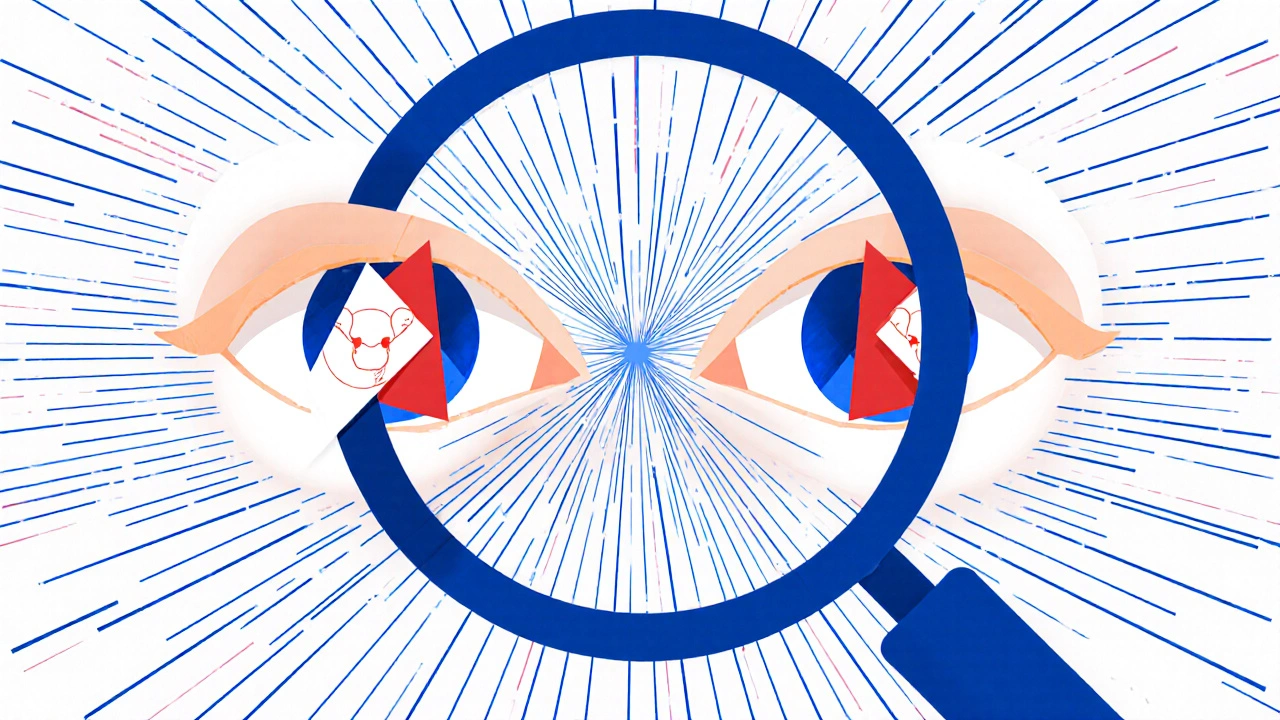What Is Thyroid Eye Disease?
Thyroid Eye Disease (TED), also called Graves’ orbitopathy, happens when your immune system attacks the tissues around your eyes. It’s not just an eye problem-it’s tied to your thyroid. About 90% of people with TED also have Graves’ disease, an autoimmune disorder that makes the thyroid overproduce hormones. But you can get TED even if your thyroid levels are normal or low. Around one in three people with Graves’ disease will develop eye symptoms, usually within the first six months after diagnosis.
The root cause? Antibodies that target the TSH receptor. These same receptors are found not just in the thyroid, but also in the fat and muscles behind your eyes. When the antibodies latch on, they trigger swelling, inflammation, and scarring. That’s what causes the bulging, double vision, and discomfort. TED usually hits both eyes, but one eye often gets worse than the other-sometimes by 30% to 40%.
Common Symptoms You Can’t Ignore
If you’ve been told your eyes are just “dry” or “allergic,” but nothing’s helping, listen closer. TED doesn’t act like a typical eye infection. Here’s what it really looks like:
- Bulging eyes (proptosis): Your eyes stick out farther than normal. This isn’t just cosmetic-it can make it hard to close your eyelids fully.
- Eyelid retraction: Your lids pull back, giving you a wide-eyed, startled look. People often say you look “angry” or “staring,” even when you’re not.
- Grittiness or dryness: 78% of patients describe their eyes as gritty, like sand is rubbing against them. Some eyes water nonstop, others feel parched.
- Double vision: About half of moderate to severe cases involve diplopia. Looking up, down, or sideways becomes a challenge because the eye muscles swell and stick.
- Pain behind the eyes: Especially when you move your eyes. It’s not a headache-it’s deep, sharp, and tied to motion.
- Light sensitivity: Bright lights, screens, or sunlight feel unbearable. This affects 60% of patients.
- Blurred vision: Can come and go, but if it’s persistent, it’s a red flag.
Severe cases can lead to corneal ulcers from exposure, or worse-optic nerve compression. In 85% of these cases, color vision fades first. If you notice colors looking dull or washed out, don’t wait.
How Is It Diagnosed?
TED is often missed. A 2023 study found primary care doctors misdiagnose it as allergies or sinus issues nearly half the time. That’s dangerous. Early diagnosis saves vision.
A full workup includes:
- Thyroid blood tests: TSH, free T4, free T3. If you have Graves’, you’ll likely see low TSH and high T4/T3.
- Anti-TSHR antibody test: Levels above 15 IU/mL strongly suggest TED and predict how well you might respond to newer drugs like Tepezza.
- Eye exams: Doctors check eyelid position, eye movement, pressure, and vision fields. A tool called the Clinical Activity Score (CAS) measures redness, swelling, pain, and other signs of active inflammation. A score of 3 or higher means your disease is still flaring-and needs treatment now.
- Imaging: CT or MRI scans show which eye muscles are swollen. The medial rectus (inner muscle) is affected in 90% of cases. OCT scans look for nerve damage.
Don’t settle for a quick glance. You need an ophthalmologist who specializes in thyroid eye disease. Academic centers get it right 92% of the time. Community clinics? Only 32%.

Treatment: From Steroids to Breakthrough Drugs
Before 2020, treatment options were limited. Steroids helped some, but with big risks. Now, there’s real hope.
Mild cases: Selenium supplements (100 mcg twice daily) cut the risk of progression by 35%. It’s simple, safe, and backed by European trials.
Moderate to severe active TED: Intravenous steroids (methylprednisolone) are still common-60-70% respond well. But side effects are real: liver damage in 15%, blood sugar spikes in 25-30%. Most doctors limit this to 12 weeks.
The game-changer: Tepezza (teprotumumab)
FDA-approved in January 2020, Tepezza is the first drug made just for TED. It blocks the IGF-1R receptor, which drives the inflammation behind eye swelling. In clinical trials:
- 71% of patients saw reduced eye bulging-compared to only 20% on placebo.
- 68% had double vision improve-versus 29% on placebo.
It’s given as 8 infusions, every 3 weeks. Each dose costs about $5,500. Total: $44,000. Insurance often denies it-35% of requests get rejected. But if you qualify, the results can be life-changing.
Side effects? Muscle cramps in 65%, hearing loss in 12% (usually temporary). The FDA now requires monitoring for hearing changes after treatment.
Surgery: When Drugs Aren’t Enough
Once the inflammation settles (usually after 12-24 months), surgery can fix what’s left.
- Orbital decompression: Removes bone behind the eye to create space. Used in 5-10% of cases, especially if the optic nerve is squished. Endoscopic methods (through the nose) are now used in 65% of cases-less scarring, faster recovery.
- Strabismus surgery: Realigns eye muscles to fix double vision. Works in 30-40% of cases.
- Eyelid surgery: Fixes retraction. Success rate: 75-85%. Best done at least 6 months after inflammation stops.
Many patients need more than one surgery. About 20% require multiple procedures over time.
What You Can Do Right Now
Smoking increases your risk of TED by 7.7 times and doubles your chance of severe disease. Quitting is the single most effective thing you can do-even if you already have it.
Don’t delay. The window for the best results? Within the first 12 months of symptoms. If you wait too long, the inflammation becomes permanent scarring. No drug can reverse that.
Get help fast. Go to an endocrinologist and an ophthalmologist who specialize in TED. Many top hospitals now have dedicated TED clinics. They cut diagnosis time by 45 days.
Track your symptoms. Apps like TED Tracker let you log eye pain, bulging, and vision changes. It helps your doctor see patterns and decide when to act.
The Future Is Here
Tepezza isn’t the end-it’s the beginning. In 2023, the FDA approved it for teens as young as 12. The European Medicines Agency did too.
New drugs are coming. Rituximab shows promise for people who don’t respond to Tepezza. Biosimilars of Tepezza are expected in 2025, which could drop the price significantly.
Researchers are testing anti-IL-6 drugs and even vaccines to stop TED before it starts. The goal? Prevent Graves’ disease from ever turning into eye disease.
For now, if you have Graves’ and your eyes feel off-don’t wait. Get checked. Document your symptoms. Ask for the CAS score. Push for Tepezza if you’re moderate to severe. And quit smoking. Your eyes-and your future-depend on it.
Real Stories, Real Impact
A 42-year-old woman in Ohio regained her ability to drive after 18 months of double vision. Tepezza cleared it up. A 35-year-old man in Texas lost vision permanently because his doctor thought it was a migraine. He waited six months.
Patients report embarrassment, anxiety, and even job discrimination because of their appearance. One Reddit user said, “I stopped going to family gatherings because I looked like I was always mad.”
But the same people who got treated early say: “I feel like myself again.”
What to Ask Your Doctor
- Is my disease still active? What’s my Clinical Activity Score?
- Do I have anti-TSHR antibodies? What’s my level?
- Am I a candidate for Tepezza? Will you help me with insurance pre-approval?
- Are you referring me to a TED specialist or a multidisciplinary clinic?
- Should I get imaging? Which type-CT or MRI?
- Have you seen my case before? How many TED patients do you treat each year?






Esperanza Decor
November 11, 2025 AT 00:10Don't let anyone tell you it's 'just dry eyes.' If you have Graves', and your eyes feel off, push for the CAS score. It's not optional.
Deepa Lakshminarasimhan
November 11, 2025 AT 00:48Erica Cruz
November 12, 2025 AT 18:41Johnson Abraham
November 13, 2025 AT 07:36Shante Ajadeen
November 14, 2025 AT 14:39Danae Miley
November 15, 2025 AT 09:46Charles Lewis
November 17, 2025 AT 09:01Renee Ruth
November 19, 2025 AT 00:44Samantha Wade
November 20, 2025 AT 04:42Elizabeth Buján
November 21, 2025 AT 09:07Andrew Forthmuller
November 23, 2025 AT 08:21vanessa k
November 23, 2025 AT 18:51manish kumar
November 23, 2025 AT 19:43Nicole M
November 24, 2025 AT 06:22